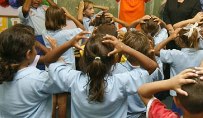 Immediately she looked at me AND smiled. She relaxed and started talking! It was like turning on a light. Jenny, epitomizes satisfaction
Immediately she looked at me AND smiled. She relaxed and started talking! It was like turning on a light. Jenny, epitomizes satisfaction
Recently I was lucky enough to go on a trip to a remote area of the Northern Territory to work for a week with an indigenous community. The community I visited, Elliott, is exactly halfway in between Alice Springs and Darwin. The nearest town is Tennant Creek, 250 km to the south.
After flying into Alice Springs and visiting the hearing centre there I began the long drive north. What is normally a baron, red desert is now lush and green, following months of record rainfall. Parts of the highway are still submerged or damaged due to the force of the rainwater. Six hours on the road I arrived in Tennant Creek where the hotelier was expecting me. I was greeted unconventionally upon entrance with a short “Took your time”. Well, yes, I am from Melbourne, and as such am not yet accustomed to driving at Territory speeds!
The next morning I met the Nurse Audiometrist who I would be travelling with. He lives here and knows the Barkly Region of the Territory intimately; all the back roads, short cuts, roads best avoided in wet weather, the communities, the elders and the health workers. His experience and expertise are invaluable and when he retires next year expects his position, sadly, will remain unfilled. It will be an enormous loss to indigenous health. Word has got around! As he sees me, he greets me with a friendly “I’d heard you took your time”. We load up the 4WD and zoom up the highway, this time at Territory speeds. We are there in no time!
Elliott is a little township, which is unlike a truly remote area as you can drive there, yet its distance from amenities classifies it as ‘Remote’. About 500 people live here all up, all but a few being indigenous. There is a primary school, a corner store, a mechanics yard and a health centre, this being my clinic for the next few days. I have come with a list of referrals and patients who need to be seen. I soon find out that my appointment list is merely a work of fiction. Patients turn up in their own time. Patients who I very much want to see, remembering their conditions from my last visit 6 months prior, I have to chase down, asking the health workers to search the community for them. Initially I am shocked by the health conditions of the people I see. Almost every person who walks into the clinic has a conductive hearing loss, often it is severe, perforated eardrums too are common and infections are typical. If I saw a patient with these conditions in Melbourne, I would immediately refer them to the Eye and Ear Hospital for urgent ENT opinion. However there is no ENT service here. The best we can offer is counseling patients how to make ’tissue spears’ which can then be placed in the ear canal to drain out external fluids from infections. We talk about the importance of hand washing and learning to blow your nose and together with a Remote Area Nurse and a visiting medical student we are inspired to make a difference. I have come with a supply of ‘bone conductor’ hearing aids. These are hearing aids that sit behind the ear on the mastoid bone and transfer sound to the cochlear via bone conduction. These aids are well suited to this population who frequently have discharging ears and middle ear pathology, therefore cannot wear standard hearing aids. I fit several to the school children and show their teachers how to care for them.
Whilst an overwhelming amount of work must be done here, getting it done, bit-by-bit, is incredibly satisfying. Jenny, epitomizes such satisfaction. Jenny, the teachers’ aide at the local school, was encouraged to come to the clinic by her friends. She had recently started working at the local school and was having trouble hearing her students, yet, despite such a drawback; she obviously had developed a strong rapport with the children. When Jenny came into the clinic she stared at the ground and spoke in a quiet mumble. A hearing test revealed a severe mixed hearing loss. This is an incredible loss for anyone to deal with, let alone someone who works in a school. Luckily I was able to fit her with a bone conductor aid on the spot. Immediately she looked at me AND smiled. She relaxed and started talking! It was like turning on a light. Jenny was still working at the school the next time I visited Elliott. She now manages the children’s hearing aids as well as her own. The teachers rely on Jenny as the ‘go to’ person when a child’s hearing aid appears to not be working. When I think of what we should be doing as audiologists, I think of Jenny, now engaged in her community, able to work effectively and able to be a role model and hands-on-help to hearing impaired indigenous children.
Returning to the cold of Melbourne I began to miss the warmth of the Territory. Through my ‘Melbourne eyes’ I saw the people of Elliott as disengaged, living in poverty with very poor health outcomes. However, leaving Alice Springs airport, I realized my perspective had changed. I respected the happy relaxed lifestyle I was leaving: one focused on the importance of communal values and spiritual wellbeing rather than the needless material wealth that drives so many. Yes, indigenous Australians’ health situation is tragic in its state, disconcertingly poor when compared to the majority of Australia. Yet in so many respects they have a wonderful lifestyle, one based on community, mutual obligation and the friendly warmth of the sun. I very much hope to go back to the Territory to help and work for longer so I too can partake in such a lifestyle.
